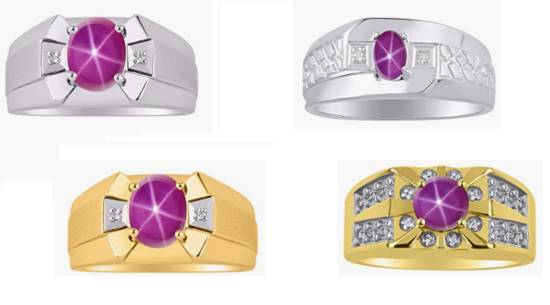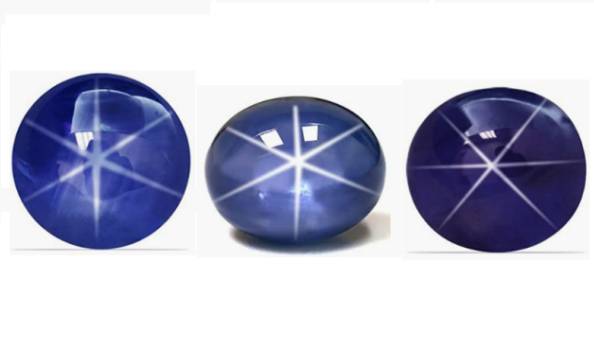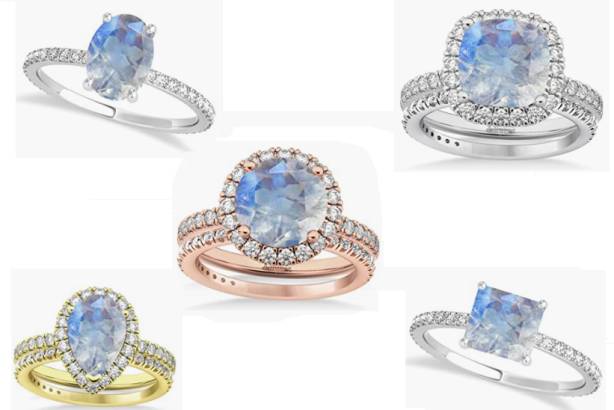Phenomenal gemstones glisten or glow with delicate hues that defy description. The following conditions can transform a dazzling gem into a phenomenal one.
- Presence of suitable types of inclusions.
- Optimum alignment of these inclusions inside the body of the gem.
- And optimal light conditions.
Properties of Phenomenal Gemstones:
Phenomenal gemstones exhibit visually delightful optical effects. Let us try to understand what are these profoundly fascinating phenomena.
Asterism in Phenomenal gemstones:
We see this phenomenon on the dome face of cabochon-cut gems. Intersecting beams of reflected light spawn a six-ray star-like visual. Asterism appears in the cabochon dome and is we can observe it in gems like sapphires, rubies and less frequently in other gemstones. Tiny needles of Titanium oxide (known as rutile inclusion) crowded together in a specific pattern in the gem crystal cause Asterism.
Phenomenal Gemstones Star Ruby Rings
Phenomenal Gemstones Star Sapphires
Adularescence:
Why does the sky appear blue?
A natural phenomenon called Raleigh scattering causes the sky to appear blue. It happens because minute particles in the atmosphere scatter sunlight. Consequently, diffuse sky radiation reaches our eyes. Though only a small portion of around 33% of light is scattered, the smallest wavelengths scatter readily. Further, these shorter wavelengths link to blue hues. Hence, we see the sky in blue color.
A similar scattering of light by microscopic layers of feldspar inclusions inside a gem emits a bluish-white milky glow. It looks like moonlight shining through a veil of clouds and is known as Adularescence. Moonstone is the only gem that exhibits this phenomenon.
Phenomenal Gemstones Moonstone Rings
Aventurescence in Phenomenal gemstones:
Aventurescence, also known as aventurization, is an optical effect seen in certain light-sensitive gemstones. Tiny mica inclusion mineral platelets create a sparkling, twinkling, metallic glitter when correctly oriented. The platelet inclusions are so plentiful that they also affect the gemstone’s body color.
“Aventura” means “by chance” in Italian, and that is the root word for the name of our phenomenon, aventurine or aventurescence. Researchers accidentally discovered aventurine glass or goldstone in the 18th century. Consequently, they named the phenomenon alluding to chance discovery. We artificially imitate aventurine quartz and feldspar (sunstone) to manufacture Goldstone even today.
Chatoyancy:
Alternatively known as the ‘cat’s eye effect,’ chatoyance is an optical phenomenon that causes a band of reflected light to move just beneath the surface of a cabochon-cut gemstone. Light reflection from many parallel needle-like inclusions inside a cabochon conjures up the spectacle. The inclusions can also be fibrous or tube-like.
We can observe chatoyancy most prominently in chrysoberyl and tiger’s eye, two phenomenal gemstones materials best-known for this phenomenon. Chrysoberyl exhibits the best chatoyance in fine specimens. Also, tiger’s-eye is the chatoyant gem often used in jewelry.
See more Phenomenal Gemstones As Follows:
| Chatoyancy | Asterism in Star Gemstones |
| Adularescence and Labradorescence | Gemstone Fluorescence |


